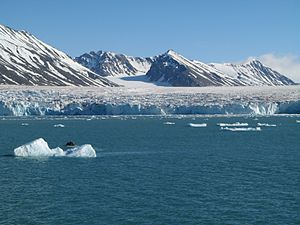Monacobreen
| Monacobreen | ||
|---|---|---|
|
Monacobreen seen from Liefdefjord |
||
| location | Haakon VII Land , Svalbard | |
| Type | Outlet glacier , tidal glacier | |
| length | 40 km | |
| surface | 408 km² (1993) | |
| Exposure | North | |
| Altitude range | 1250 m - 0 m | |
| Tilt | ⌀ 2 ° (3%) | |
| width | Max. 2.8 km | |
| Ice thickness | ⌀ 225 m | |
| Coordinates | 79 ° 24 ' N , 12 ° 34' E | |
|
|
||
| drainage | Liefdefjord , Woodfjord , Arctic Ocean | |
| particularities | Surge glacier | |
The Monacobreen (also Monaco Glacier ) is a tidal glacier in Haakon VII Land in the northwest of the island of Svalbard . The approximately 40-kilometer-long glacier flowing from the Isachsenfonna - ice cap at an altitude of about 1250 meters north to Liefdefjord in which it calves . In the Liefdefjord, the Monacobreen joins the much smaller Seligerbreen flowing in from the west and forms with it a five-kilometer-long edge. The area of the Monacobreen was determined in 1993 with 408 km². The average gradient is about two degrees. The ice thickness is estimated at 225 meters. Like all glaciers in Svalbard, the Monacobreen has lost its substance since the Little Ice Age , between 1966 and 1990 the end of the glacier retreated by about one kilometer.
The glacier is named in honor of Prince Albert I of Monaco , who explored the area with Gunnar Isachsen in 1906 and 1907 .
Surge activity in the late 20th century
The Monacobreen is a surge glacier , i.e. a glacier in which significantly higher flow speeds occur in phases. The Monacobreen is even considered the prototype of the Spitsbergen type of this phenomenon. The last active phase took place in the 1990s and lasted more than six years. At the beginning of this decade, expedition leaders working in the area reported a significantly increased crevice formation in the Monacobreen. Over three years the flow speed of the glacier increased considerably, with the end of the glacier advancing two kilometers. About half of the increase in speed took place between September 1991 and March 1992. The maximum was reached in 1994 and was 5 meters per day. The increase in speed began almost simultaneously in the entire lower part of the glacier and later spread upwards. There was therefore no surge front that migrated down the glacier. Until 1998, over more than three years, the speed gradually decreased again to the original level. Such a characteristic seems typical of the surge glaciers in Svalbard, which end in the sea. The theoretical speed derived from the area and shape of the glacier during the resting phase is 2.2 to 3.0 meters per year, which corresponds to 6 to 8 millimeters per day. It can therefore be assumed that the factor for the increase in speed during the active phase is in the order of 100 to 1000.
Individual evidence
- ^ A b Olav Liestøl: Glaciers of Svalbard, Norway. In: Richard S. Williams Jr., Jane G. Ferrigno (Eds.): Satellite Image Atlas of Glaciers of the World - Europe. 1993 ( online )
- ↑ a b c d T. Murray, T. Strozzi, A. Luckman, H. Jiskoot, and P. Christakos: Is there a single surge mechanism? Contrasts in dynamics between glacier surges in Svalbard and other regions. In: Journal of Geophysical Research. 108, 2003, pp. 2237–2251 ( doi : 10.1029 / 2002JB001906 )
- ↑ Seligerbreen . In: The Place Names of Svalbard (first edition 1942). Norsk Polarinstitutt , Oslo 2001, ISBN 82-90307-82-9 (English, Norwegian).
- ^ Markus A. Bissig, René Baldinger, Rolf Stange: Spitzbergen 12-21. September 2008 on board S / V Noorderlicht (PDF; 5.3 MB)
- ↑ Monacobreen . In: The Place Names of Svalbard (first edition 1942). Norsk Polarinstitutt , Oslo 2001, ISBN 82-90307-82-9 (English, Norwegian).
- ↑ Hester Jiskoot: Glacier Surging. In: Vijay P. Singh, Pratap Singh, Umesh K. Haritashya (Eds.): Encyclopedia of Snow, Ice and Glaciers. Springer, Dordrecht 2011, pp. 415-428, ISBN 978-90-481-2641-5
- ^ Kurt Cuffey, WSB Paterson: The physics of glaciers. Forth Edition. Butterworth-Heineman, Amsterdam 2010, ISBN 0-12-369461-2 , page 527

